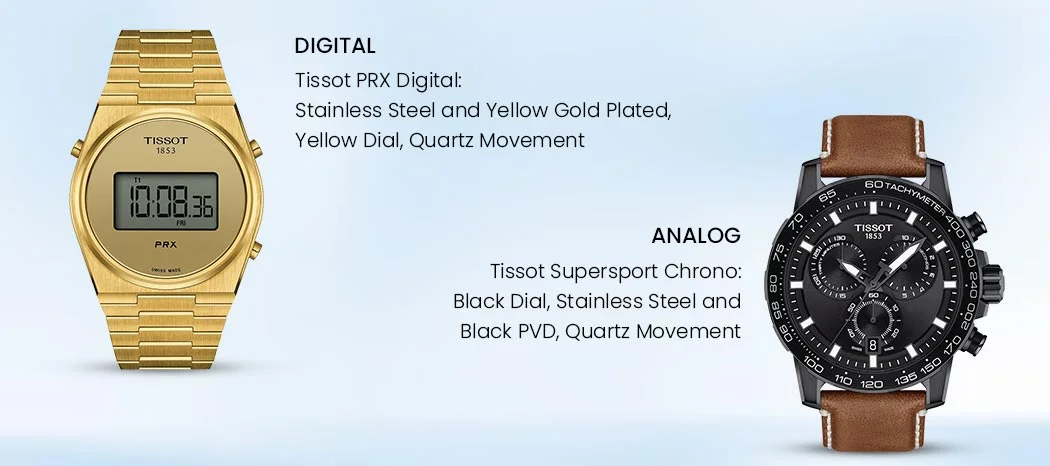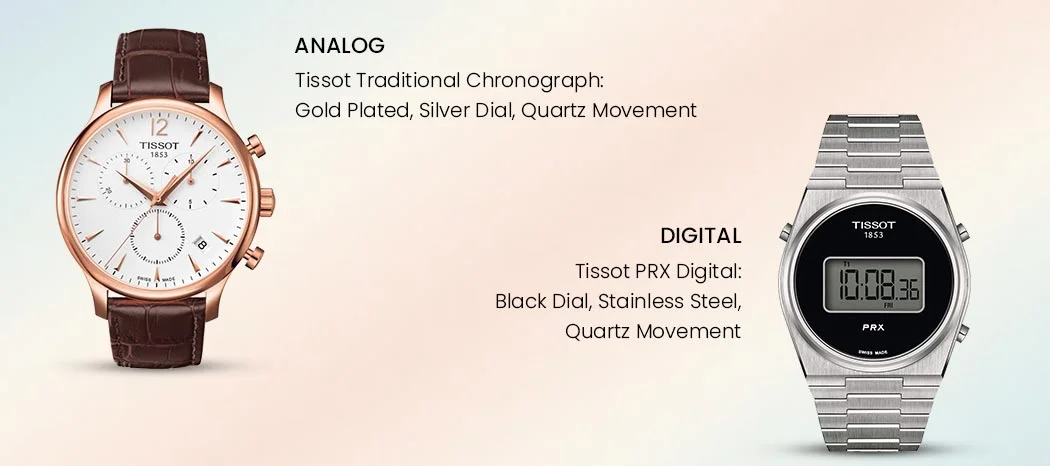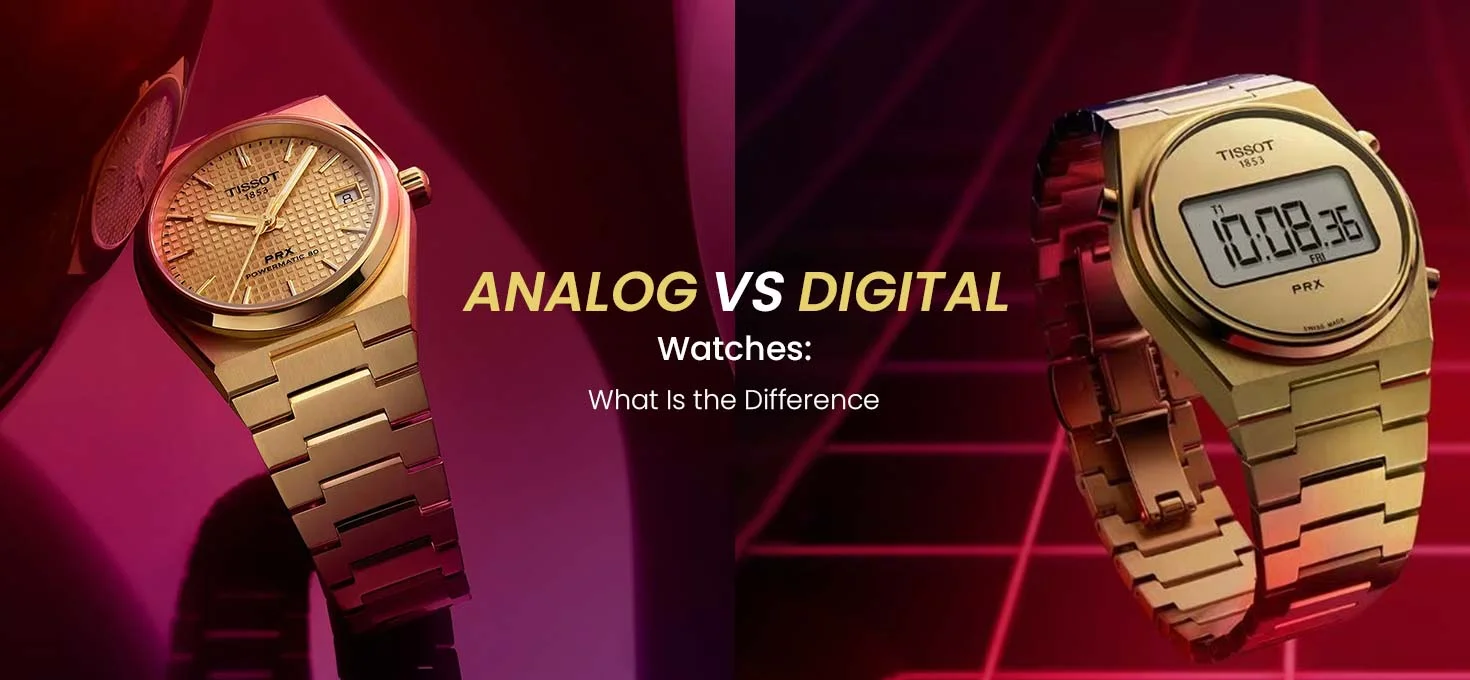Picking the right watch can be challenging, given the many options available. One common question that surfaces is whether to lean towards an analog or digital watch.
Analog watches keep it classic, displaying time with hands and hour markers, offering a timeless appeal. On the flip side, digital watches show time digitally on LED screens, giving off a modern vibe.
To make the right choice, think about what matters most to you. Do you prefer the traditional charm of analog watches, or are you more drawn to the convenience of digital ones? Consider factors such as movement, display clarity, features, and price to find the watch that fits your style and needs best. Whether you lean towards the everlasting elegance of analog or the sleek functionality of digital, rest assured, there’s a watch out there perfectly tailored to your style and preferences.
Digital or Analog? Finding Your Timepiece Identity in Luxury Watches
Let’s explore the characteristics of digital and analog watches together, helping you find the one that truly reflects your personality and style.
The Top Analog and Chronograph Watches Differences

Significance of Movements
The core of a watch lies in its movement, the internal system responsible for timekeeping. When comparing digital and analog watches, their movement stands out as the key differentiator. While digital watches rely on batteries and quartz crystals for their movement, analog timepieces can also utilize quartz, although many higher-end brands often opt for complex mechanical movements.
Digital Quartz Movements
Inside a digital watch, a simple yet crucial mechanism ticks away—powered by a quartz crystal, two circuits, a battery, and a microchip. Electricity prompts the quartz to vibrate, generating the pulse that regulates timekeeping. For every 32,768 vibrations, an electric pulse triggers the counter circuit, converting it into binary data processed by the microchip. This data drives the display screen, showing the time. Though precise, digital quartz movements may lose about 20 seconds monthly due to environmental influences such as temperature and air pressure.
Analog Quartz/Mechanical Movements
Analog Quartz/Mechanical Movements: Analog watches, favored by luxury brands, feature both quartz and mechanical movements. The quartz crystal vibrates similarly to digital watches in quartz analog watches, but the process diverges from there. Electric pulses from the quartz regulate a stepping motor, which, in turn, drives the gears, rotating the hands to display time.
Analog mechanical movements, conversely, are the epitome of traditional craftsmanship. In these watches, kinetic energy powers the semi-circular rotor in automatic movements, or the wearer winds the mainspring manually in manual movements. As the mainspring unwinds, it releases energy through a series of gears, ultimately propelling the hands forward. This meticulous process, involving hundreds of precisely assembled components, adds historical significance and collector’s value to mechanical watches.
Distinctive Display Characteristics
The interface of a watch, its display, is the window through which time is perceived, guided by the watch’s movement. While the movement is fundamental, the display truly distinguishes watches. Digital timepieces feature LCD or LED displays, whereas analog watches rely on hands and hour markers for time representation.
Digital Displays
Digital displays efficiently convey time using alphanumeric characters, often supplemented with day and date indicators. Some digital designs flawlessly blend analog elements, integrating hands and hour markers alongside digital readouts. These displays prioritize functionality over aesthetics, offering clear and precise timekeeping.
Analog Displays
Anchored by hands, hour markers, and a protective crystal, analog displays present time elegantly. With additional features such as date windows, cyclops lenses, and ornamental bezels, analog watches showcase complex design possibilities. Numerous high-end brands achieve a delicate balance between style and function, offering both everyday sports watches and detailed complications.
Understanding Price Differences
The contrast in watch prices between analog and digital models is significant. While you can find a decent digital watch for less, top-tier analog timepieces can command prices in the thousands or even millions. Various factors contribute to these price differences, including materials, craftsmanship, movement complexity, and added features. Brand reputation and market demand also play crucial roles, particularly for vintage or rare pieces.
Digital Watch Prices
Digital watches typically feature quartz movements that are mass-produced and assembled in factories. With millions of units churned out yearly, supply often exceeds demand, resulting in relatively low prices. However, the incorporation of advanced features in modern watches elevates their value, necessitating the use of premium materials and cutting-edge technology. While digital watches excel in functionality, their innate worth may appreciate less than analog timepieces, making them more appealing for immediate use rather than long-term assets.
Analog Watch Prices
High-end analog watches can carry hefty price tags, reaching the thousands or even millions for exceptional pieces. The complicated craftsmanship involved in their production, with many components meticulously assembled by hand, contributes to their elevated prices. Luxury brands often develop proprietary materials and utilize precious gems, further adding to the cost. Limited production runs and high demand for these prestigious timepieces result in prices far exceeding production costs.
Luxury analog watches from esteemed brands tend to maintain value and may even appreciate over time, rendering them stylish accessories and valuable investment assets.
Exploring Watch Characteristics
Both digital and analog watches offer an array of additional features. Digital timepieces, driven by quartz mechanisms, excel in functionalities such as precise timekeeping and stopwatch capabilities. In contrast, analog watches offer functionalities such as stopwatches, multiple time zone tracking, and moonphase displays. However, the inclusion of each additional feature notably raises the price, necessitating enhancements in display features and movement complications. Analog watches, particularly those with mechanical movements, demand detailed craftsmanship and manual labor to integrate these features, unlike their digital counterparts, which often rely on advanced functionalities. While digital watches can support more features, the added functions in analog watches hold more value due to the craftsmanship and complexity involved in their creation. This garners recognition from collectors and watch aficionados.
Choosing Your Timepiece: Deciding Between Digital Efficiency and Analog Elegance

The ideal watch hinges on your purpose behind owning one. If functionality is your top priority, a digital watch offers practicality. However, an analog watch is indispensable if you seek a timepiece with more profound significance beyond mere timekeeping. Luxury analog watches from esteemed brands leverage the timeless elegance of analog displays and evoke a connection to history through their mechanical movements. Although luxury analog watches typically have a higher price tag than their digital counterparts, they maintain their value over time.
Best of Both Worlds: Kapoor Watch Co. – Discover Dual Appeal of Digital and Analog Collection
You can expand your collection now that you have become well-versed in analog and digital watches.
Explore our exceptional range of digital and analog timepieces, where style seamlessly merges with functionality. At Kapoor Watch Co., our collection masterfully combines the precision of digital technology with the classic craftsmanship of analog design, offering you the ultimate combination.
Whether you prioritize efficiency or appreciate the complexity of traditional watchmaking, our dual collection caters to your diverse preferences. Kapoor Watch Co. guarantees a perfect match for every discerning individual, offering everything from sleek digital watches with advanced features to painstakingly crafted analog timepieces exuding luxury and heritage.
If you are a fan of analog and digital watches, there’s something special in store for you. Our website offers a wide selection of Swiss-made analog timepieces for both men and women. Each watch embodies the traditional minimalist look that many watch enthusiasts adore. Embrace versatility with Kapoor Watch Co.’s collection, where innovation harmoniously coexists with tradition. Explore our comprehensive range today and take your wrist game to new heights.
Frequently Asked Questions
Q1: How Do I Determine if I Need a Digital or Analog Watch?
A1: Assess your needs and preferences; digital watches prioritize functionality, whereas analog watches excel in both function and style, serving as versatile accessories.
Q2: Do Digital Watches Lack the Craftsmanship of Analog Luxury Watches?
A2: Digital watches prioritize technology, while analog luxury watches often feature complex craftsmanship and mechanical movements.
Q3: What Advantages Do Digital Watches Have Over Analog Watches?
A3: Digital watches excel in precision and ease of reading and often include advanced features such as multiple time zones and sensors.
Q4: Are Analog Watches More Difficult To Maintain Than Digital Watches?
A4: Analog watches may require periodic servicing due to their mechanical movements. Digital watches, being electronic, generally have simpler maintenance needs, often involving battery replacements.
Q5: Can Luxury Analog Watches Be Worn for Sports or Outdoor Activities?
A5: While some luxury analog watches are designed with robust features, digital watches may be less sport-specific. It’s advisable to check the watch specifications to ensure suitability for particular activities.





Recent Posts
Recent Comments
Archives